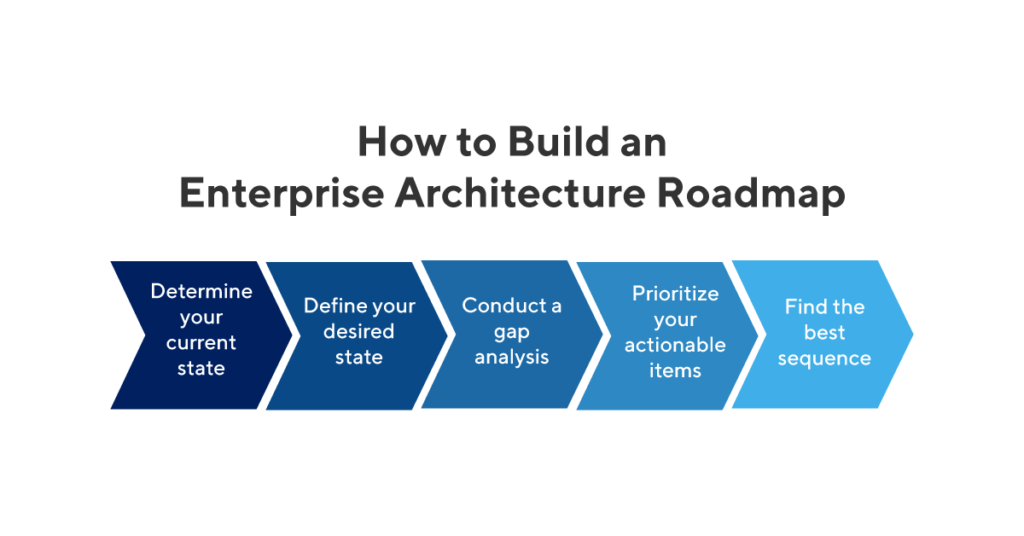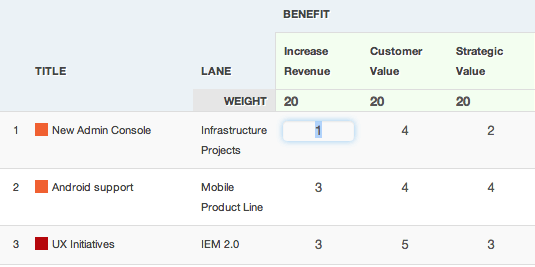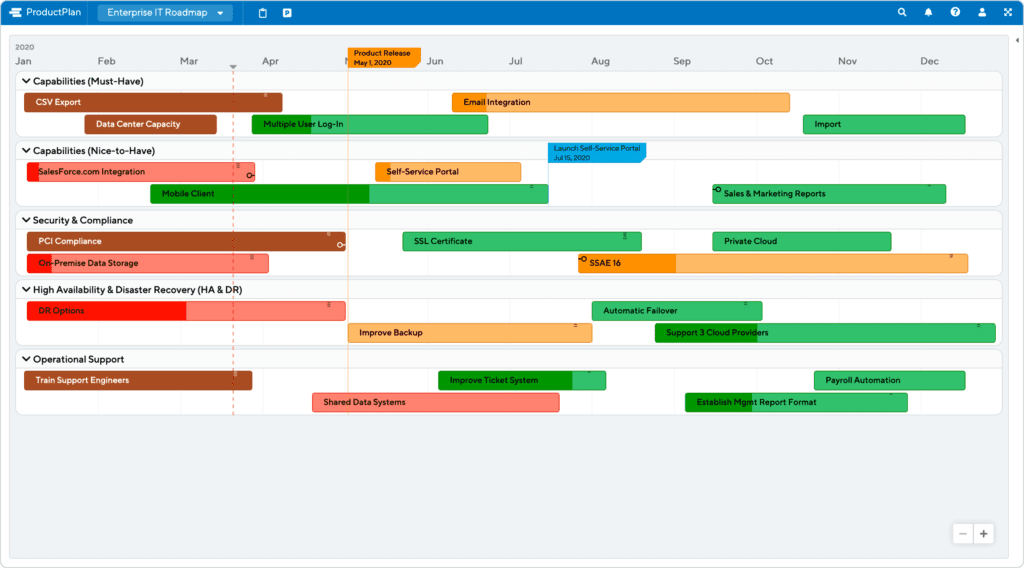What is an Enterprise Architecture Roadmap?
An enterprise architecture roadmap is a strategic blueprint that communicates how a company’s IT plans will help the organization achieve its business objectives. These roadmaps can be developed for initiatives such as:
- Communicating a change management plan — for example, to move the company to new tools or technology.
- Implementing the digital transformation of a legacy, offline process.
- Addressing all IT processes needed to support company-wide compliance with new or changing data-protection regulations.
Why Do You Need an Enterprise Architecture Roadmap?
For enterprise architects, CIOs, and other IT professionals, a roadmap is a helpful tool that can visually demonstrate a direct link between the company’s IT planning and the organization’s broader needs and goals.
Organizing a complex IT initiative into a strategic, visual roadmap, rather than simply documenting the tactical tasks required, can have several benefits for both the enterprise architects developing the roadmap and the company as a whole. For example:
1. It can help earn stakeholder buy-in
When executives, investors, or department heads ask to view an enterprise architect’s plan or recommendation to implement a significant IT change, they will be looking for the big-picture benefits the organization should expect from it.
They will want to know how the implementation will make the company more efficient, how it will boost employee productivity, how the organization will derive a competitive advantage from it — and, ultimately, how it will increase the business’s bottom line.
Presenting this IT plan in roadmap format allows the enterprise architect to focus stakeholders’ attention on only the major themes of the plan — for example, “move our mission-critical digital assets to a fully managed Data-Protection-as-a-Service model” — so these stakeholders will focus on the strategic picture, how the IT plan aligns with the company’s own goals, rather than getting lost in the tactical details.
2. A roadmap is a versatile tool that lets you share the right details with each audience
For stakeholders who want to view your IT plans at a more granular level than the visual summary contained in your roadmap’s large themes, the right roadmap tool (a native roadmap app) can allow you to drill into the details of any theme or epic on the roadmap and show estimated timeframes, resource requirements, anticipated budgets, interdependencies with other elements on the roadmap, etc.
This is why roadmaps are such versatile tools. They allow you to present the same IT plans in different ways depending on your audience.
For those interested in the broad vision and strategic thinking behind your plan, you can show the roadmap’s visual display: just the big themes and epics your plan consists of and the outcomes you’re aiming for.
For your more tactical audiences, you can easily switch the roadmap to a more detail-oriented view. Developers, for example, will want to discuss the technical implementation details. The finance team might want to discuss the budgetary implications of each element in your roadmap’s plan. For these audiences, you can drill down into those details of the roadmap.
3. It can help your team strategically stay on track and work on the right priorities
IT planning reflects the team’s best estimates at a given time. But during the execution phase of any complex IT initiative, things can and likely will change.
Having a strategically focused blueprint — an enterprise architecture roadmap — can serve as a helpful reference point throughout a project that lets the IT team make sure the adjustments they’re considering making still serve the main objectives of the plan.
Download the Guide to Roadmap Software ➜
How do you Develop an Enterprise Architecture Roadmap?

We at ProductPlan have written posts offering guidance on creating roadmaps in general, and in particular how to build your first product roadmap.
Developing an enterprise architecture roadmap follows many of the same steps and exercises. So, we will defer here to enterprise architect thought leader James Parnitzke, who offers a six-step process for building an enterprise architecture roadmap.
STEP 1: Determine your “current state.”
If you want to develop a roadmap for an IT implementation, tech migration, or another major company initiative, you first need to get a clear understanding of where your organization stands today in relation to that objective.
This means asking (and tracking down the correct answers to) questions such as:
- What are our functional needs to successfully execute on this IT plan?
- What business and technical assets do we have that can help us accomplish this big objective? Which assets are we lacking, and can we find alternatives for them?
- What disruptions if any will this implementation create across the organization? Are there ways to mitigate or minimize those disruptions?
- What business and technical assets do we have that can help us accomplish this big objective? Which assets are we lacking, and can we find alternatives for them?
STEP 2: Define your “desired state.”
Next, you’ll want to develop and write down a clear picture of what success with this enterprise architecture plan will look like — your desired future state. That means, for example, deciding which metrics to focus on and what improvements specifically you’ll be hoping to see from with each, such as:
- Increased profitability
- Reduced costs
- Entry into new markets
STEP 3: Conduct a gap analysis.
Now that you’ve articulated clearly where your company is and where you want to take it, you can begin identifying the specific areas your team will need to improve to reach your desired state. These items will likely make up the main themes or epics on your enterprise architecture roadmap.
The actionable items you come up with during this stage in your roadmap development could include any or all of the four main architecture domains:
- Business
- Information (data)
- Application
- Technology
STEP 4: Prioritize your actionable items.
You’ll now want to review all of the actions you identified in the previous step and order them according to priority. You can use any number of prioritization models, but one we often turn to is the cost versus benefit approach, which you can use right in the ProductPlan roadmap app to objectively measure the relative value of your list of actionable items.

Opportunity scoring tool available in the ProductPlan roadmap app
STEP 5: Find the best sequence.
At this point, you will have determined the main actionable items needed to complete your planned new architecture implementation, and you will have ordered those key items in terms of their relative priority.
A critical next step is to determine the most effective sequence to begin executing on these items. You won’t necessarily want to tackle them in order of priority without considering other factors first. For example:
- Are there dependencies that could affect the order of the team’s work?
- Will rolling out some of these changes have a better effect on company adoption, buy-in, and morale than others?
STEP 6: Develop and publish the roadmap.
Finally, you will now be ready to turn that well-thought-out, strategically sequenced list of major action steps into an enterprise architecture roadmap.
Parnitzke’s description of this final step addresses the importance of distilling your plan into a high-level strategic summary — rather than a tedious list of tasks and details, which is what most roadmaps look like initially.
Fortunately, with the right roadmap app (see below), this step should be very easy. Purpose-built roadmap apps are designed to let you highlight a high-level summary of your major themes, and then include more granular detail behind those themes but make it visible only in the appropriate circumstances (such as during a meeting with your technical team).
Sample of IT roadmap templates built in the ProductPlan roadmap app
Download the Guide to Roadmap Software ➜
Tips for Your Enterprise Architecture Roadmap
Here are a few best practices to help guide your roadmap development.
Focus on only a few strategic themes
When thinking through the details of a planned update to your enterprise architecture, it can be very easy to become overwhelmed with ideas for new processes, new technology, new people, etc. But the ideal enterprise architecture roadmap will focus on just a few main themes and then allow the relevant teams to fill in the ground-level details. This will keep your roadmap clear and compelling.
Include key performance indicators
You are more likely to gain acceptance of (and even enthusiasm for) your roadmap if it includes measurable goals. When your stakeholders can see that your roadmap has its own built-in, unambiguous success metrics, they are more likely to take it seriously. Moreover, including these success metrics will help keep you and your team on track throughout the execution because you will know exactly what you are aiming for.
Download Product Success Metrics ➜
Meet with all relevant subject matter experts across the company
The success or failure of an enterprise architecture roadmap depends largely on the accuracy of the information that went into developing it. When you are using a cost versus benefit approach to score and prioritize each action on your list, for example, you will need to know the true costs of each action. That means speaking with the relevant team leaders or department heads to learn this information before you complete that prioritization step.
The Enterprise Architecture Roadmap: Well Worth the Effort
For an enterprise architect or other IT professional tasked with overseeing a major IT initiative, developing a roadmap is a valuable early-stage planning exercise because it focuses and clarifies your strategic thinking, helps you prioritize the many actions competing for your team’s resources, and can help you earn both approval and help from your key stakeholders.
The good news is that with the right app, developing your enterprise architecture roadmap can be quick and simple. Here’s a page filled with technology roadmap templates your team can start using right now.
